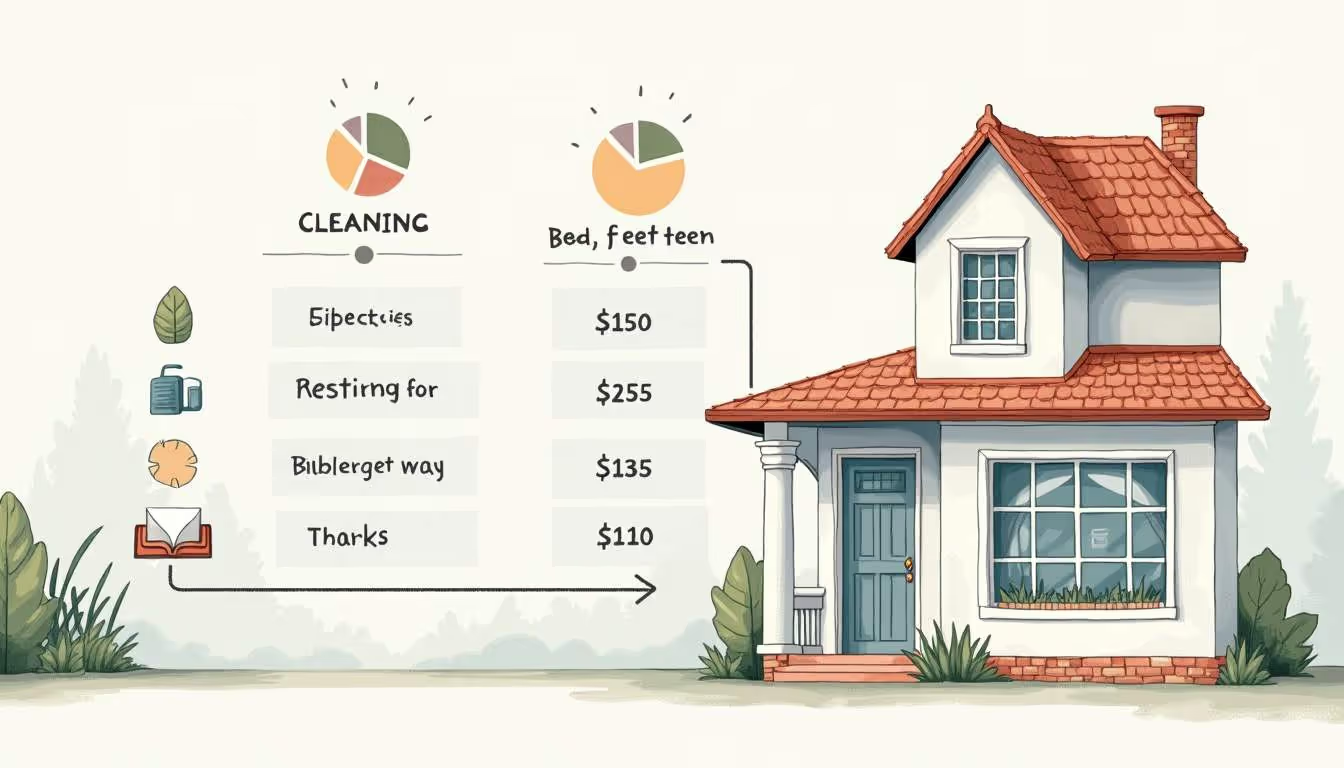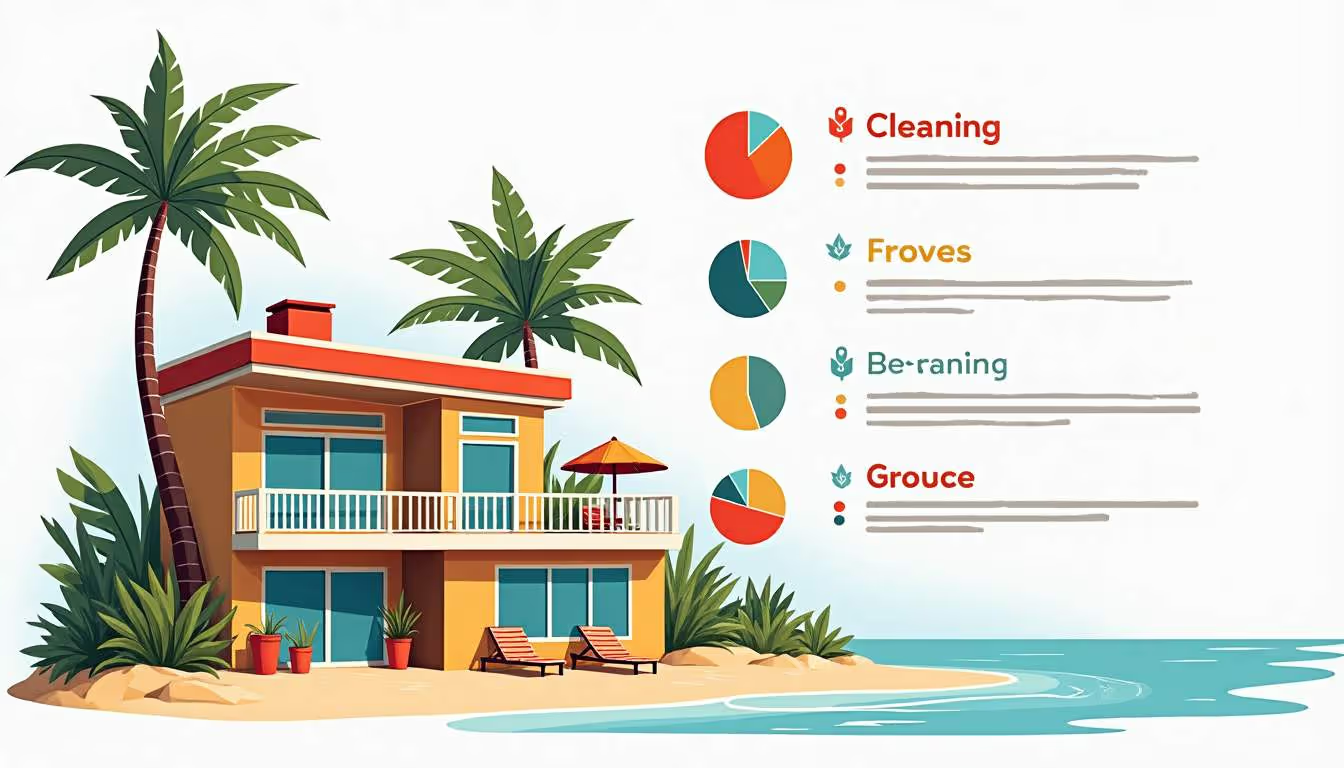How to Generate Custom Fee Breakdowns for Vacation Rental Homes
In the evolving landscape of travel, vacation rentals have emerged as a favored option for those seeking personalized stays. With this rise in popularity, ensuring transparent pricing becomes crucial. Crafting a detailed fee breakdown for vacation rental homes not only elevates the guest experience but also builds trust and transparency. This article delves into the essential elements of a thorough fee breakdown and provides actionable advice on how to construct one.
Decoding the Elements of a Fee Breakdown
To achieve transparency in fee breakdowns, it's vital to grasp the various elements that can be included. Each vacation rental may have unique fees based on its location, amenities, and management approach. Below are some of the most prevalent components to consider.

Base Rental Rate
The base rental rate serves as the foundation for any fee breakdown. This is the charge guests incur for using the property over a specified duration. Setting a competitive base rate that mirrors the property's value is essential, factoring in aspects like location, size, and seasonal demand.
Conducting market research to assess similar properties in the vicinity can aid in establishing a price that appeals to guests while ensuring profitability. Additionally, employing dynamic pricing strategies that adjust rates based on demand, local events, or holidays can optimize revenue and maintain competitiveness in a bustling market.
Cleaning Fees
Cleaning fees are a common addition to the rental cost, covering the expenses of preparing the property for the next guests. Transparency about this fee is crucial, as guests value knowing their accommodations will be clean and well-maintained.
When determining cleaning fees, consider the property's size and the extent of cleaning required. Larger homes or those with more amenities may necessitate a higher cleaning fee. Clearly articulating this fee in the breakdown can help manage guest expectations. Moreover, offering a detailed description of the cleaning process, such as the use of eco-friendly products or the frequency of deep cleaning, can bolster guests' confidence in the property's upkeep.
Service Fees
Service fees can differ significantly depending on the management company or platform listing the property. These fees often cover customer service, booking management, and other operational expenses. It's vital to clarify what these fees encompass, as guests may be wary of hidden charges.
When presenting service fees, consider offering a breakdown of what guests can expect in terms of support and services. This transparency can enhance guest satisfaction and reduce inquiries about additional costs. Highlighting any value-added services included in the service fee—such as 24/7 customer support, concierge services, or local experience recommendations—can further justify the expense and enrich the guest experience. By providing this level of detail, you not only cultivate trust but also encourage guests to perceive the value in their investment, potentially leading to repeat bookings and positive reviews.
Additional Fees to Consider
Beyond the basic fees, several additional charges may apply to vacation rentals. Including these in the fee breakdown can offer guests a clearer understanding of the total cost. Here are some common additional fees to consider.
Security Deposits
Security deposits are often required to cover potential damages or excessive cleaning needs. This fee is typically refundable, provided the property is returned in good condition. Clearly stating the amount of the security deposit and the conditions for its return can alleviate guest concerns.
It's advisable to explain the process for handling security deposits, including the timeframe for refunds. This information can help guests feel more secure in their booking decision.
Pet Fees
If the property is pet-friendly, a pet fee may be applicable. This fee helps cover any additional cleaning or wear and tear caused by pets. When including this fee in the breakdown, it’s essential to specify any restrictions, such as size or breed limitations.
Clearly communicating pet policies and fees can attract pet owners while ensuring that expectations are set for all guests. This can lead to a more positive experience for everyone involved.
Utility Fees
In some cases, vacation rentals may charge additional utility fees, especially for properties that use higher amounts of electricity or water. This is particularly relevant in areas with extreme weather conditions where heating or cooling is necessary.
When including utility fees in the breakdown, it's helpful to provide context. For example, if a property has a hot tub or pool, explaining how these amenities impact utility costs can help guests understand the reasoning behind the charge.
Crafting a Transparent Fee Breakdown
Once the various components of the fee breakdown have been identified, the next step is to present this information in a clear and organized manner. Transparency is key to building trust with potential guests.
Utilizing Clear Language
Using clear and concise language in the fee breakdown is essential. Avoid jargon or complicated terms that may confuse guests. Instead, aim for straightforward explanations of each fee and its purpose.
For instance, rather than simply stating "cleaning fee," consider saying "Cleaning Fee: Covers the cost of preparing the property for your stay, ensuring a clean and comfortable environment." This approach not only informs but also reassures guests about the value they are receiving.
Visual Breakdown
Incorporating a visual breakdown can enhance the clarity of the fee structure. Consider using tables or bullet points to list each fee alongside its amount. This visual representation allows guests to quickly scan and understand the total cost of their stay.
Additionally, consider using color coding or icons to differentiate between types of fees. For example, using a broom icon for cleaning fees or a paw print for pet fees can make the breakdown more engaging and easier to digest.
Providing Total Cost at a Glance
At the end of the fee breakdown, it is vital to provide the total cost at a glance. This should include all fees, taxes, and the final amount due. Presenting this information clearly can help guests feel confident in their booking decision.
Consider using a bold font or a different color to highlight the total cost. This ensures that it stands out and is easily noticeable, reducing the likelihood of any misunderstandings regarding pricing.
Effectively Communicating the Fee Breakdown
Once the fee breakdown has been created, the next step is to communicate it effectively to potential guests. This involves choosing the right platforms and ensuring that the information is accessible and easy to find.

Listing Platforms
Many vacation rentals are listed on various platforms, each with its own way of displaying pricing. Ensure that the fee breakdown is clearly presented on all platforms where the property is listed. This includes websites, booking platforms, and social media.
Consider creating a dedicated section for pricing on the listing page, where guests can easily find the fee breakdown. This proactive approach can help reduce inquiries about costs and enhance guest trust.
Pre-Booking Communication
Effective communication before booking is crucial. Consider sending potential guests a detailed fee breakdown as part of the pre-booking process. This can be included in response to inquiries or as part of an automated message for interested parties.
By providing this information upfront, guests will feel more informed and confident in their decision-making process. It also sets the tone for transparency and professionalism.
Post-Booking Confirmation
After a booking is confirmed, sending a follow-up email that reiterates the fee breakdown can be beneficial. This serves as a reminder of the costs associated with the stay and reinforces the transparency established during the booking process.
Including a summary of the fees in the confirmation email can also help guests prepare for their stay, ensuring they are aware of any additional costs they may incur during their visit.
Adapting to Market Changes
The vacation rental market is dynamic, and pricing strategies may need to adapt over time. Being flexible and responsive to market changes is essential for maintaining competitiveness and guest satisfaction.
Seasonal Adjustments
Many vacation rentals experience seasonal fluctuations in demand. Adjusting the base rental rate and associated fees during peak seasons can help maximize revenue. Conversely, offering discounts or lowering fees during off-peak times can attract guests when demand is lower.
Communicating these seasonal changes in the fee breakdown is crucial. Guests appreciate knowing why prices may vary throughout the year, and this transparency can lead to increased bookings during slower periods.
Feedback and Adjustments
Gathering feedback from guests regarding the fee breakdown can provide valuable insights. Consider sending surveys after their stay to inquire about their understanding of the fees and whether they felt the breakdown was clear and fair.
Using this feedback to make adjustments can enhance the overall guest experience. If guests express confusion about certain fees, revisiting how these are presented in the breakdown may be necessary.
Competitor Analysis
Regularly analyzing competitors' fee structures can provide insights into industry trends and best practices. Understanding how similar properties present their fees can help in refining your own breakdown.
Consider subscribing to newsletters or following competitors on social media to stay informed about any changes they make to their pricing strategies. This knowledge can aid in maintaining a competitive edge in the market.
Conclusion
Generating a custom fee breakdown for vacation rental homes is an essential aspect of providing a transparent and trustworthy experience for guests. By understanding the various components of fees, clearly communicating them, and adapting to market changes, property owners can enhance guest satisfaction and foster long-term relationships.

Ultimately, a well-structured fee breakdown not only benefits guests but also contributes to the overall success of the vacation rental business. By prioritizing transparency and clarity, property owners can create a positive experience that encourages repeat bookings and positive reviews.
Ready to elevate your vacation rental business with seamless accounting automation and unparalleled transparency? Look no further than VRPlatform. Our comprehensive B2B SaaS solution integrates flawlessly with your Property Management Systems and payment gateways, providing you with accurate owner and manager statements, trust reconciliation, and a general ledger to streamline your financial operations. Property managers, accounting partners, and property owners alike can benefit from our platform's features, including a branded owner portal for real-time financial oversight. Take the first step towards automated accounting excellence and sign up for a free trial of VRPlatform today, and experience the peace of mind that comes with compliance and clarity.



